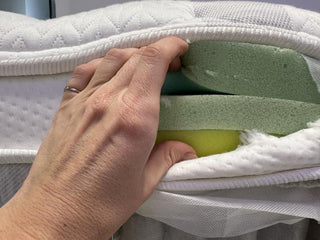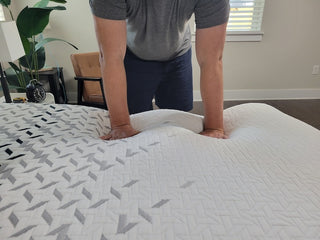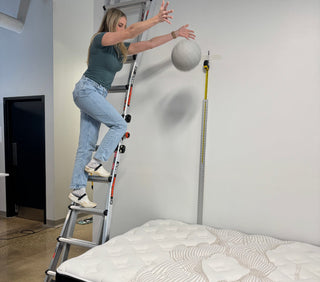For back sleepers:
Is the mattress an even-keel medium-firm that offers a balance of cushion and support?



We occasionally receive free products for testing and take part in affiliate programs, which means we may earn a commission if you purchase items through links on our site. For full details, please refer to our disclosure page.


If you’re looking to improve your sleep, shopping for a new mattress can feel intimidating. You want something that’s comfortable, affordable, and tailored to your unique needs. But where do you start? That’s where we come in.
At Dweva Mattress, we’re here to make the buying process simple and stress-free. Our reviews provide all the key details you need to find the perfect bed. Every mattress we recommend is tested in our own studio, where we evaluate its pressure relief, cooling, edge support, and much more. Then, using our proprietary analysis, we assign each mattress an overall score to help you make a confident decision.

Here’s a closer look at the performance categories we test and how we score them.
Each of these tests involves hands-on evaluation, allowing us to assess the mattress’s feel, performance, and long-term suitability for different types of sleepers.
We measure firmness on a scale from 1 to 10, where 1 represents an ultra-soft feel and 10 is very firm. The industry standard sits at around 6.5, a medium-firm level that suits the majority of sleepers.

Our review team includes testers of different body types, and we carefully consider how factors like size and weight can influence how firm a mattress feels. To determine the firmness level, multiple reviewers lie on the bed in various sleeping positions and rate its firmness on a scale from 1 to 10. We then average these scores to create an overall firmness rating.
Refer to our comprehensive mattress firmness guide for an in-depth look at different firmness levels, along with their benefits and potential drawbacks.
While we strive to keep our mattress testing as scientific and consistent as possible, we also recognize that comfort is subjective. For instance, a heavier sleeper often perceives a mattress as firmer than a lighter sleeper would. That’s why we gather feedback from testers of various body types to ensure our mattress reviews reflect a broad range of real-world experiences.
We also evaluate how comfortable each mattress feels in different sleeping positions. Most people tend to prefer one or two main positions—side, back, or stomach—and each position benefits from a specific firmness level and overall feel.
During testing, reviewers with different body types lie on each mattress in all three sleeping positions. They record detailed observations about their comfort level, the quality of support they experience, and any distinctive features they notice about how the mattress feels.
In the end, each mattress earns one of three ratings for every combination of body type and sleeping position: Unpleasant, Good, or Excellent. We then present these results in a clear, easy-to-read chart like the one shown below.

A mattress that earns a high score for pressure relief features layers designed to gently cushion your joints, minimizing pressure buildup in areas that tend to bear more weight. For instance, side sleepers often feel pressure on their shoulders and hips, where these points press into the mattress—making effective pressure relief especially crucial for them.
We evaluate every mattress to determine how well it delivers pressure relief. Our testers lie down in all three sleeping positions and ask themselves: Do we feel pressure building up around our joints, or does the mattress help to ease that tension?

We also use an electronic pressure-mapping mat to create pressure maps for each mattress. Several testers with different body types lie on the mat in both side-sleeping and back-sleeping positions. Since stomach sleepers focus more on lift and support than pressure relief, we typically exclude that position from this particular test.
The result is a color-coded pressure map that visually shows where pressure buildup occurs on the testers’ bodies. Red and orange areas represent high pressure, yellow shows medium pressure, and green and blue indicate very low or no pressure at all.


The mat also provides a PSI (pounds per square inch) reading, which helps us measure the overall pressure a tester applies to the surface. On average, side sleepers tend to show a PSI reading of about 14.58, while back sleepers average around 12.43. We use these benchmarks as reference points to determine whether a mattress offers exceptional, average, or below-par pressure-relieving performance.
We then give each mattress a pressure relief score ranging from 1 to 5, with 5 being the highest possible rating. This score is determined by combining the pressure map data with detailed feedback from our testers’ real-world experiences.
A mattress with strong edge support allows sleepers to comfortably use the entire surface of the bed. This means couples can sleep close to the edge without feeling like they’ll roll off. Good edge support also makes it easier to get in and out of bed without the sides sagging too much.
We evaluate edge support by sitting and lying directly on the edge of the mattress. During this test, we note how stable the surface feels and whether there’s any noticeable risk of sliding or rolling off.



We also place weighted plates near the edge of the mattress and use a tape measure to precisely determine how much the perimeter sinks under pressure.
Using the results from these tests, we assign each mattress an edge support score from 1 to 5, with 5 representing the highest level of stability and performance.
Many mattresses include cooling materials designed to help prevent sleepers from overheating throughout the night.
If a mattress contains latex or coils, we generally expect it to sleep cooler since both materials naturally encourage better airflow.
While memory foam mattresses tend to retain heat, some brands enhance their foams with gel, graphite, or copper infusions. These materials help disperse heat and create a cooler, more comfortable sleeping surface.
To evaluate a mattress’s cooling performance, we lie on it for an extended period and observe any noticeable temperature changes. We also use a heat-sensitive temperature gun to measure how well the mattress regulates and dissipates heat.
First, we use the temperature gun to record the mattress’s surface temperature. A tester then lies on the bed for several minutes before we take another reading. The best cooling mattresses show minimal temperature increase, while those lacking effective cooling materials can warm up quickly—sometimes by 10 degrees or more.

Finally, we assign the mattress a cooling score between 1 and 5. Only beds that show a temperature increase of less than 10°F earn an above-average rating for cooling performance.
Motion isolation describes a mattress’s ability to absorb or minimize movement. Mattresses with strong motion isolation are ideal for couples, as they help prevent one partner from feeling the other’s movements during the night.
To evaluate a mattress’s motion isolation, we conduct several tests. First, we place a glass of water on one side of the bed and create movement on the opposite side. If the water remains still, the mattress performs exceptionally well at isolating motion. However, if the water ripples noticeably, it indicates that motion is transferring across the surface.

Next, one of our testers lies on one side of the mattress while another moves around on the opposite side—changing positions, rolling over, and getting in and out of bed. This simulates the movements of a partner during the night. If the first tester remains undisturbed, it means the mattress provides excellent motion isolation.
Finally, we drop a medicine ball onto the mattress and use a seismometer to measure how much motion travels across the surface. The flatter the seismometer reading, the better the mattress performs in motion isolation.
We then average the results from all these tests to determine a final motion isolation score on a scale from 1 to 5.
A responsive mattress quickly bounces back to its original shape without leaving noticeable body impressions. It feels springy and allows for easy movement, preventing that “stuck” sensation some mattresses can create.

We evaluate a mattress’s responsiveness by rolling and shifting positions on its surface. With slower-moving memory foam mattresses, we often experience excellent pressure relief but limited mobility. In contrast, latex or hybrid mattresses tend to feel more buoyant, making movement easier—though they typically provide less contouring and pressure relief.
We assign each mattress a responsiveness score from 1 to 5, with 5 indicating exceptional bounce and quick recovery.
Sinkage refers to how much a mattress surface compresses under weight. Some sleepers enjoy a deeper, plusher sink-in feel, while others prefer the sensation of sleeping more “on top” of the mattress for added support and mobility.

To measure sinkage, we place a 44-pound kettlebell on the mattress and record how far it sinks into the surface. On average, the indentation is typically around 3 inches deep.
We use this average measurement to assign the mattress a sinkage rating of Light, Moderate, or Deep.
Bounce describes how springy a mattress feels and how strongly it pushes back when pressure is applied. To measure it, we drop a 15-pound medicine ball from a ladder and record how high it rebounds after hitting the mattress surface.

Our average bounce measurement is about 16 inches in height. We use this benchmark to assign each mattress a bounce rating of Low, Moderate, or High.
This category is especially important for restless or sensitive sleepers, as well as for sexually active couples who prefer a mattress that allows for easier movement and responsiveness.
We give each mattress a noise score from 1 to 5. If the bed produces noticeable sounds when we move on it, it receives a lower score.
A mattress that’s ideal for sex should offer a mix of key qualities: strong responsiveness, solid edge support, and quiet performance. To rate each bed’s suitability for sex, we average its responsiveness, edge support, and noise scores to produce a final rating between 1 and 5.
Beyond performance testing, we also evaluate each mattress based on the customer experience. These assessments help us understand how easy or challenging it is to order, unbox, set up, and return the mattress.
When you purchase a mattress online, you’re typically offered a trial period—also known as a sleep trial—that allows you to test the bed at home for a set number of nights. During this time, you can usually return the mattress with little to no fee if it doesn’t meet your expectations.
We rate each mattress’s trial period on a scale from 1 to 5. Beds offering longer trials—typically several months to a full year—earn higher scores.
A mattress warranty protects you from paying out of pocket for defects or structural issues. The most generous warranties last 10 years or more and cover replacements, exchanges, or refunds for mattresses that show excessive wear beyond normal use.
It’s essential to review the warranty terms before purchasing your mattress so you understand what’s included. For instance, some companies will replace or repair your mattress if it sags beyond a specified depth within the warranty period.
We assign each mattress a warranty score from 1 to 5, based on the warranty’s duration and the specific terms of coverage.

When a mattress arrives at your home, you’ll usually need to unbox it and place it on a frame. We evaluate how easy or challenging this process is, noting how manageable it is to lift, move, and set up the mattress.
We then give each mattress a setup score from 1 to 5, with 5 representing an effortless and smooth transition from box to bedroom.

Most mattresses need some time to fully expand once they’re unboxed and unwrapped. In our testing lab, we closely monitor this process to measure how long each mattress takes to reach its full shape. We then rate them on a scale from 1 to 5, with 5 indicating complete expansion in under 24 hours.
When you unbox a new bed-in-a-box mattress, you might notice a mild chemical odor at first. This scent is common and typically fades within 48 hours as the mattress airs out.
When testing bed-in-a-box mattresses, we carefully monitor how strong the initial odor is and how long it takes to fade. We’ve found that all-foam mattresses usually take longer to off-gas than innerspring models, while natural latex mattresses often have a mild, earthy “barnyard” scent that typically dissipates after a few days.
We give each mattress an off-gassing score from 1 to 5, with 5 meaning there was little to no noticeable odor, and 1 indicating the smell lingered for more than three days.
Here’s some additional information about mattress off-gassing and a few tips on how to eliminate that familiar “new mattress smell.”
After completing all our tests, we calculate an overall mattress score on a scale from 1 to 5. This final number represents a weighted average of both performance and customer experience scores. A rating of 4 or higher indicates a high-quality, high-value mattress according to our testers and experts.